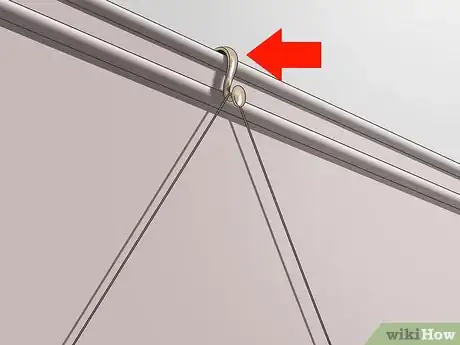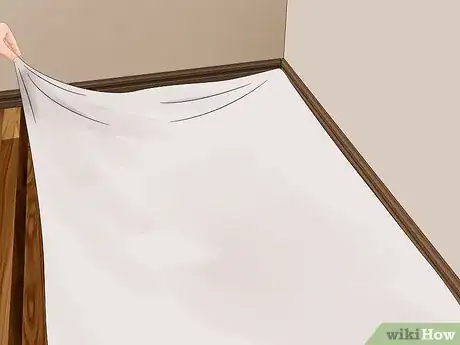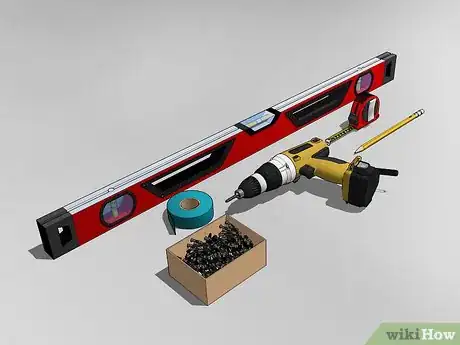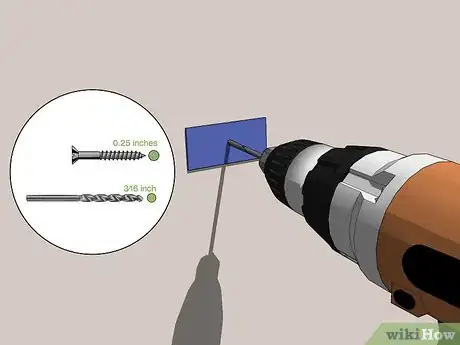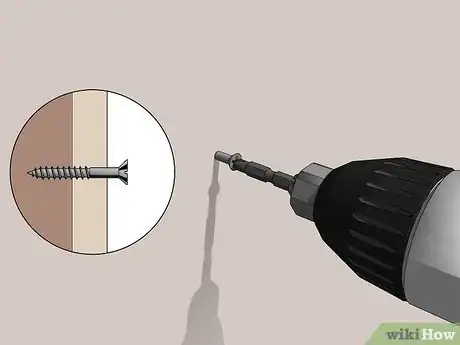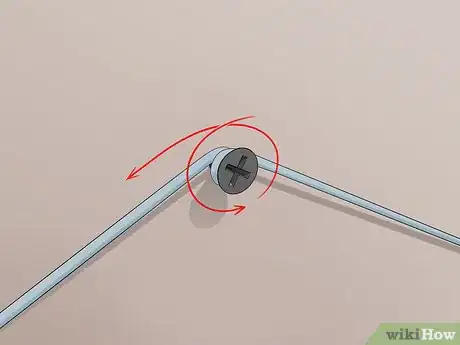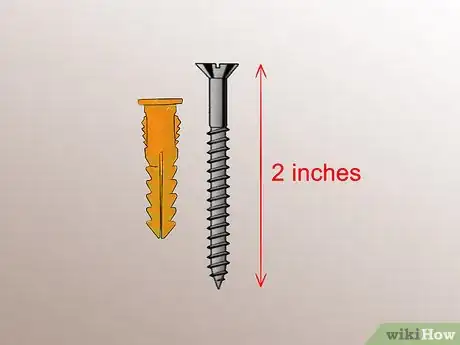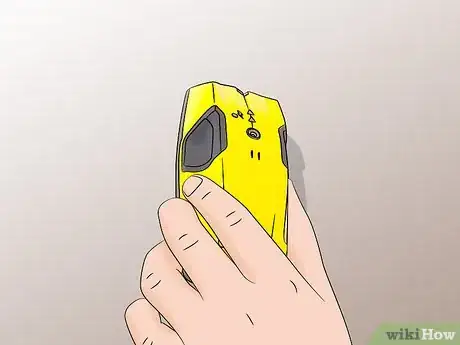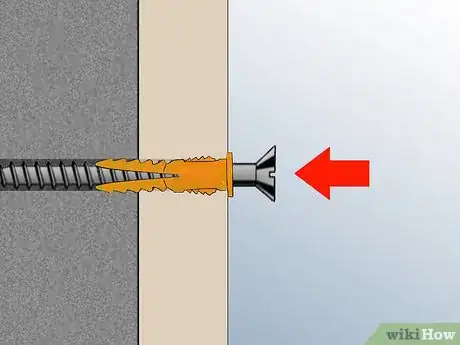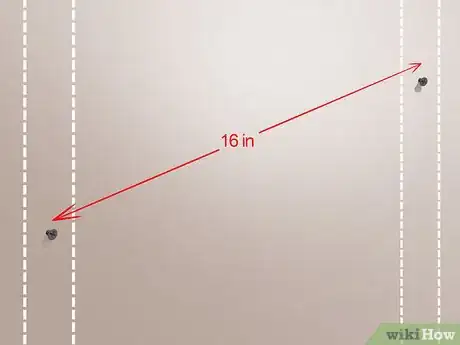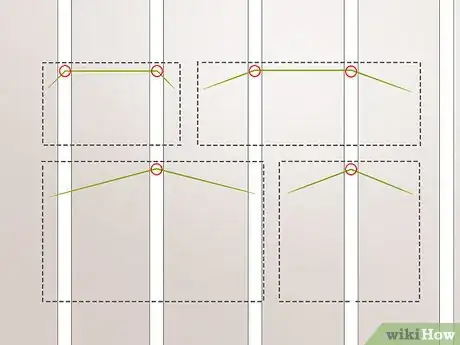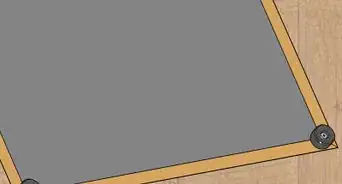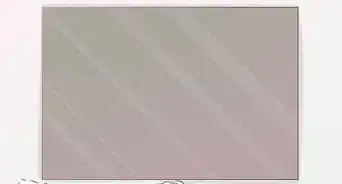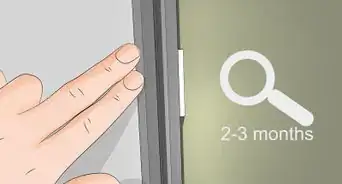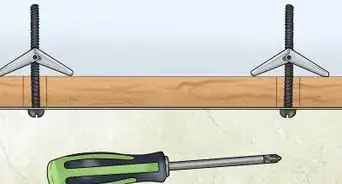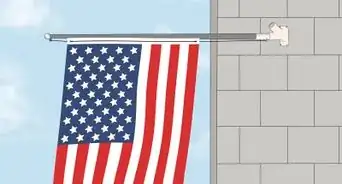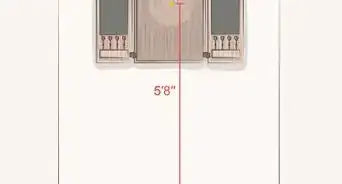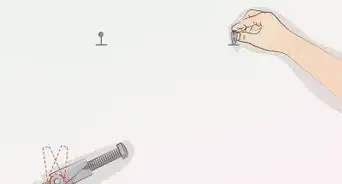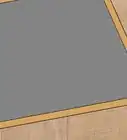This article was co-authored by Jeff Huynh. Jeff Huynh is the owner of Moseybolt, a full service solution in home services, renovations, and repair in the Greater Seattle area. He has over five years of handyman experience. He has a BS in Business Administration from the San Francisco State University and his Certificate in Industrial Electronics Technology from North Seattle College.
This article has been viewed 99,763 times.
Many older homes (and some modern ones) have plaster walls. They seem difficult to work with: they're thick, hard, and brittle. It's actually not too hard to hang things on plaster walls, however, as long as you use screws and work slowly and carefully. Pre-drill the holes, and use fairly long screws to ensure a secure fit. If you're hanging heavy objects, use screws with anchors for added protection.
Steps
Starting the Process
-
1Use a picture rail if you have one. Some older plaster walls have a thin strip of wood that runs around the perimeter of a room, usually between 1 inch (2.5 cm) to 1 foot (30 cm) below the edge of the ceiling. If your room has this, you can simply drive a screw through the wood, and use this to hang things.[1]
- For instance, drive a screw into the strip on the spot just above where you want to hang a picture. Attach one end of a wire to the screw, and the other end to the hook on the back of the picture.
- You can raise or lower the wire to get the picture to the correct height.
-
2Lay down a drop cloth. Set a drop cloth or an old sheet on the floor directly below where you want to hang something on the wall. Drilling holes into plaster can create dust and crumbs. Setting down the cloth will make clean-up a breeze.Advertisement
-
3Gather your supplies. You won't need anything unusual or complex, and everything can be found at a hardware store if you don't already have it. You'll need a:
- Box of screws that are 1.25 inches (3.2 cm) long, or 2 inches (5.1 cm) long for hanging heavy objects
- Roll of painter's tape
- Pencil
- Drill and a set of drill bits
- Measuring tape
- Carpenter's level
- Magnetic stud finder (optional)
- Roll of wire for hanging the object (optional)
Hanging Light Objects
-
1Mark the spot where you want to hang the object. Place a piece of painter's tape on the wall roughly where you want the object to be. Then use the measuring tape to measure the height of the exact spot. Mark it on the painter's tape using a pencil.
- The painter's tape will help keep the plaster from cracking when you drill into it.
-
2Pre-drill a hole. Use a drill bit that is narrower than the width of the screws you are using. For instance, if you are using screws that are 0.25 inches (0.64 cm) wide, use a drill bit that is 3⁄16 inch (0.48 cm). Drive the bit into the wall at the spot you marked.
- Work carefully, holding the drill at a right angle to the wall. Plaster is hard, so you will feel some resistance. That resistance may increase if the drill enters the lathe (the wooden support that holds up the plaster).
-
3Drive a screw into the spot you marked. Switch to a screwdriver attachment on your drill. Drive a screw almost all of the way in. Leave a bit of distance between the screw head and the wall surface.[2]
-
4Hang your object. Wrap one end of a wire tightly around the screw head. Attach the other end to the hook or support on the object you want to hang. Adjust the wire length until the object is at the height you want.
- Some objects (like many picture frames) will have a hole in the back that you can set directly on the screw to hold it in place.
- Use a level to fine-tune the placement of your object.
Hanging Heavy Objects
-
1Use heavy-duty hardware. To secure heavy items on plaster walls, use screws that are 2 inches (5.1 cm) long. If possible, get screws that have plastic anchor attachments to help hold them in place.
-
2Find a stud, if you can. Use a magnetic stud finder to locate the wooden studs hidden behind the plaster wall. Try to find one at the spot where you would like to hang the object. Heavy objects will be more secure if they are held in place by screws driven into the stud.[3]
- Most stud finders will light up when they find a stud.
- If you find a stud, mark the spot on the wall. Then use a measuring tape to make a straight line going up the wall from this spot. Along that line, mark the height where you actually want to hang the object on a piece of painter's tape.
- You can hang heavy items in plaster walls without driving screws into a stud. However, you should use screws with anchors to be more secure.
EXPERT TIP"Studs are the framing that hold the wall up. They're installed first, then plaster or drywall is applied on top."
Jeff Huynh is the owner of Moseybolt, a full service solution in home services, renovations, and repair in the Greater Seattle area. He has over five years of handyman experience. He has a BS in Business Administration from the San Francisco State University and his Certificate in Industrial Electronics Technology from North Seattle College.
Jeff Huynh
Professional Handyman Jeff Huynh
Jeff Huynh
Professional Handyman -
3Pre-drill a hole at the spot where you want to hang the object. Use the same procedure as you would for hanging light objects. However, make sure to use a drill bit that is just a bit smaller than the width of the anchor if you are using one.
- For instance, a screw that is 0.25 inches (0.64 cm) wide may have an anchor that is 0.3 inches (0.76 cm) wide. Use a drill bit that is no larger than 0.25 inches (0.64 cm).
-
4Tap the anchor into the hole you drilled. If possible, just use the pressure of your hand. If the anchor won't go in that way, gently tap it with a light hammer until it is flush with the wall. Be very careful, however. Plaster is brittle and can crumble if you accidentally hit it with the hammer.
- If you do end up with a crack or small hole in your wall, you may be able to repair it with a plaster compound repair kit. Look for one at a hardware store. Basically, you will need to carefully smear the compound into the damaged area, smooth it out, and let it set.
Expert AnswerQWhen asked, "How does a drywall anchor work?"
Jeff Huynh is the owner of Moseybolt, a full service solution in home services, renovations, and repair in the Greater Seattle area. He has over five years of handyman experience. He has a BS in Business Administration from the San Francisco State University and his Certificate in Industrial Electronics Technology from North Seattle College.Professional Handyman
 EXPERT ADVICEAnswer from Jeff Huynh:
EXPERT ADVICEAnswer from Jeff Huynh:Jeff Huynh, the general manager of Handyman Rescue Team, answered: "The anchor expands when you place it in a hole in the drywall. That friction creates holding force once the screen is installed, provided there's enough support behind the wall."
-
5Drive the screw into the anchor. This should be fairly easy, but you can use the drill with a screw attachment to do it quickly. Don't drive the screw all the way in. Leave a small distance between the screw head and the surface of the wall.
- Attach the hanger on the back of the object to the screw on the wall. Or, if you prefer, you can wrap one end of a piece of wire tightly around the screw head, then attach the other to the object's hanger.
- Check the placement of your object with a level to make sure it's even.
Installing Multiple Hangers
-
1Insert more screws, if necessary. If the object is large or very heavy, put another screw in the wall to the side of the first one, using the same procedure. This will help distribute the weight of the object and keep it more secure on the wall.[4]
- If possible, drive the second screw into a stud. Move the stud finder about 16 inches (41 cm) to the side of the first screw and try to locate another stud. This is the standard distance between studs, but it can vary widely.
- Before you drill the second screw's anchor hole, place a level on the line between the first screw and the spot where you want the second one to be. Raise or lower the second screw's spot to make things even.
- Have someone help you with the hanging if the object is very heavy or cumbersome.
-
2Map out the screw locations if you are hanging multiple objects. If you want to hang several objects at the same height, start with the location of the first screw. Figure out the distance you want there to be between the middle of one object and the middle of one next to it. Using your measuring tape and a pencil, mark out that distance to the right or left of the first screw.
- If you want the objects to sit at the same height, put a level on the line you measured out to ensure the screws are even with each other.
- If you want the objects to sit at different heights, measure up or down from the second mark. For instance, if you want the second object to sit 4 inches (10 cm) higher and 18 inches (46 cm) to the right of the first one, measure out 18 inches (46 cm) to the right of the first screw. Then measure 4 inches (10 cm) up from there and put the second screw in.
- Keep measuring, leveling, and installing screws until you have them all in position.
-
3Hang shelving. Most shelves consist of a set of anchors (usually 2-3) that hold up the shelving material. These anchors usually require at least 2 screws apiece. Measure the height you want the shelf to be, and pre-drill one hole there. Set the anchor in place, then drive a screw in. Predrill a hole for the second (and third, if necessary), and install that screw.
- To install the additional anchors, measure out the required distance right or left of the first one (depending on where you want the shelf to sit).
- Set a level on the line made by your tape measure to make sure the second anchor will be even with the first.
- Install the screws as you did for the first anchor.
- Follow the instructions that came with your shelving to determine the required distance between your anchors.
- If you are hanging a heavy shelf, try to get help from someone to make the task easier.
Things You'll Need
- Box of screws that are 1.25 inches (3.2 cm) long, or 2 inches (5.1 cm) long if you are hanging something heavy.
- Drop cloth
- Roll of painter's tape
- Pencil
- Drill and a set of drill bits
- Measuring tape
- Carpenter's level
- Magnetic stud finder (optional)
- Roll of wire for hanging the object (optional)
References
About This Article
Hanging things on plaster walls is easy if you have a drill and screws. All you need to do is pre-drill a hole slightly narrower than your screws, then use the drill to drive a screw into the hole. Make sure you leave half an inch out of the wall so you have space to hang your artwork. You can hang it by a wire or string or by a mount on the back of the frame. To hang heavier items, use screws that are at least 2 inches long. You should also use screws with plastic anchor attachments if you can. All you need to do is drive the anchor into your pre-drilled hole, then push the screw into the plastic anchor. If you have a magnetic stud finder, you can also use this to locate the wooden studs behind your plaster wall and screw directly into those. This will provide more security for heavier items. For more tips from our Home Improvement co-author, including how to install shelving in a plaster wall, read on!
